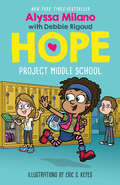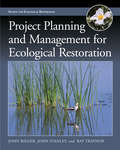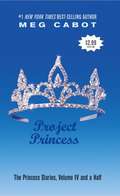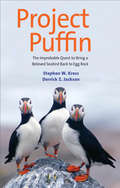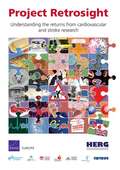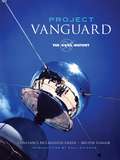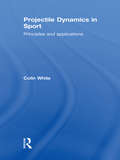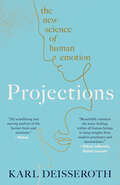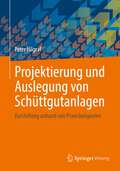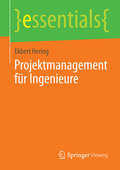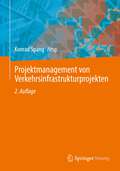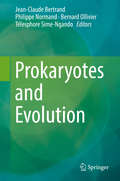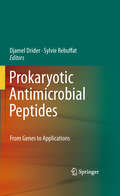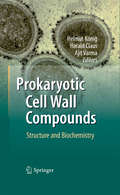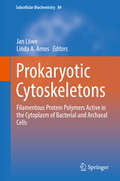- Table View
- List View
Project Middle School (Alyssa Milano's Hope #1)
by Debbie Rigaud Alyssa MilanoFrom actor and lifelong activist Alyssa Milano comes Hope Roberts, a girl who's determined to change the world.Hope is eleven years old, and she wants to be an astrophysicist. She loves swimming, Galaxy Girl comic books, her best friend Sam, and her two rescue dogs.Hope believes it's always a good day to champion a cause, defend an underdog, and save the future. And most of all, she believes in dreaming big. That's why she's enrolled in all of the advanced classes at her new middle school. She's smart and confident in her abilities. But though Hope seems super strong on the outside, there's another side of her, too. She's just a regular girl trying to survive middle school.It's the beginning of sixth grade, and Hope's BFF quickly meets a new group of friends in her classes. Hope doesn't know how to handle it. She and Sam have always been inseparable! Things don't go as well for Hope. She embarrasses herself in front of her whole class, and then she gets off on the wrong foot with her new classmate, Camila. Even science club doesn't go as planned. None of the boys in the club will listen to the girls' ideas, and Hope and Camila get stuck doing the boring part of their science project, even though it was their idea. But Hope is determined to prove herself to the boys -- even if it means doing a lot of extra work on her own. She knows that sometimes changing the world starts small. So now Hope has a mission! Can she turn the science club into a place that's welcoming for everyone -- and make some new friends along the way?Hope's relatability, kindness, empathy, and can-do attitude will inspire a generation of do-gooders. This new series is a response to the very palpable feeling that not only can young people save the world -- they will!
Project Planning and Management for Ecological Restoration (Science Practice Ecological Restoration)
by John Stanley John Rieger Raymond TraynorProject Planning and Management for Ecological Restoration addresses a problem that is the reason many current restoration projects are not as effective or successful as they could be: a lack of understanding of the principles of sound planning and management. John Rieger, John Stanley, and Ray Traynor, who collectively have decades of experience implementing successful restoration projects, provide a straightforward framework for developing and executing an ecological restoration project in order to maximize its potential for success. The authors focus on process, planning, design, implementation, and management rather than science. They describe a simple project management plan, identify the design approaches and the commitments that decisions require, and explain how design theory is translated to on-the-ground project design. The book includes numerous illustrations, as well as a series of checklists and tables to help restorationists recognize and then correct problems that may arise.
Project Princess (The Princess Diaries Volume IV and a Half)
by Meg CabotFrom the back cover: "Hammer in hand, Princess Mia embarks on an epic adventure for one so admittedly unhandy: Along with her cohorts from school, she's off to build houses for the less fortunate. It doesn't take Mia long to realize that helping others -- while an unimpeachably noble pastime -- is very hard work. Will her giving spirit prevail? Will the house collapse due to royally clumsy construction? And most importantly, will Michael stop working long enough to kiss her?"
Project Puffin
by Derrick Z. Jackson Stephen W. KressDetails a wildlife scientist's successful efforts to restore puffin colonies in Maine through an experiment in habitat restoration.
Project Retrosight
by Stephen Hanney Alexandra Pollitt Jonathan Grant Steven Wooding Martin BuxtonThis work explores impacts of cardiovascular and stroke research funded 15-20 years ago and draws out aspects associated with high or low impact. It describes 29 case studies of grants from Australia, Canada and UK. Policy summary volume.
Project Star: The Universe In Your Hands
by Harold P. Coyle Harvard Observatory StaffFun activities to learn about the universe and astronomy.
Project Vanguard: The NASA History (Dover Books on Astronomy)
by Paul Dickson Milton Lomask Constance Mclaughlin GreenThis is the inside story of one of the earliest successful U.S. satellites, a fascinating Cold War-era chronicle of the nation's earliest battles and triumphs in the Space Race. It recounts the origins, development, and results of Project Vanguard, a pioneering venture in the exploration of outer space. Primarily an analysis of the project's scientific and technical challenges, this volume documents onboard experiments, instrumentation, tracking systems, and test firings. It also portrays the drama of organizing an unprecedented project under the pressure of a strict time limit as well as the tempestuous climate of American opinion during the Soviet Union's Sputnik launches. The history concludes with an evaluation of the satellite program's significant contributions to scientific knowledge. Numerous historic photographs highlight the text, which is written in accessible, nontechnical language. In addition to a historic foreword by Charles A. Lindbergh, this new edition features an informative introduction by Paul Dickson. Authoritative and inexpensive, it will appeal to students and teachers of history and science as well as aviation enthusiasts.
Project-Based Inquiry Science: Animals in Action
by Janet L. Kolodner Joseph S. Krajcik Daniel C. Edelson Brian J. ReiserNIMAC-sourced textbook
Project-Based Inquiry Science: Astronomy
by Janet L. Kolodner Joseph S. Krajcik Daniel C. Edelson Brian J. Reiser Mary L. StarrNIMAC-sourced textbook
Project-Based Inquiry Science: Digging-In
by Janet L. Kolodner Joseph S. Krajcik Daniel C. Edelson Brian J. Reiser Mary L. StarrScience textbook
Project-Based Inquiry Science: Ever-Changing Earth
by Janet L. Kolodner Joseph S. Krajcik Daniel C. Edelson Brian J. Reiser Mary L. StarrLearning by Design TM derives from Problem-Based Learning and suggests sequencing, social practices, and reflective activities for promoting learning. It engages students in design practices, including the use of iteration and deliberate reflection.
Project-Based Inquiry Science: Good Friends and Germs
by Janet L. Kolodner Joseph S. Krajcik Daniel C. Edelson Brian J. Reiser Mary L. StarrNIMAC-sourced textbook
Project-Based Inquiry Science: Living Together
by Janet L. Kolodner Joseph S. Krajcik Daniel C. Edelson Brian J. Reiser Mary L. StarrNIMAC-sourced textbook
Project-Based Inquiry ScienceTM: Genetics
by Janet L. Kolodner Joseph S. Krajcik Daniel C. Edelson Brian J. Reiser Mary L. StarrNIMAC-sourced textbook
Projectile Dynamics in Sport: Principles and Applications
by Colin WhiteHow can we predict the trajectory of a baseball from bat to outfield? How do the dimples in a golf ball influence its flight from tee to pin? What forces determine the path of a soccer ball steered over a defensive wall by an elite player? An understanding of the physical processes involved in throwing, hitting, firing and releasing sporting projectiles is essential for a full understanding of the science that underpins sport. This is the first book to comprehensively examine those processes and to explain the factors governing the trajectories of sporting projectiles once they are set in motion. From a serve in tennis to the flight of a ’human projectile’ over a high jump bar, this book explains the universal physical and mathematical principles governing movement in sport, and then shows how those principles are applied in specific sporting contexts. Divided into two sections, addressing theory and application respectively, the book explores key concepts such as: friction, spin, drag, impact and bounce computer and mathematical modelling variable sensitivity the design of sports equipment materials science. Richly illustrated throughout, and containing a wealth of research data as well as worked equations and examples, this book is essential reading for all serious students of sports biomechanics, sports engineering, sports technology, sports equipment design and sports performance analysis.
Projections: A Story of Human Emotions
by Karl DeisserothA groundbreaking tour of the human mind that illuminates the biological nature of our inner worlds and emotions, through gripping, moving—and, at times, harrowing—clinical stories&“Poetic, mind-stretching, and through it all, deeply human.&”—Daniel Levitin, New York Times bestselling author of The Organized MindKarl Deisseroth has spent his life pursuing truths about the human mind, both as a renowned clinical psychiatrist and as a researcher creating and developing the revolutionary field of optogenetics, which uses light to help decipher the brain&’s workings. In Projections, he combines his knowledge of the brain&’s inner circuitry with a deep empathy for his patients to examine what mental illness reveals about the human mind and the origin of human feelings—how the broken can illuminate the unbroken.Through cutting-edge research and gripping case studies from Deisseroth&’s own patients, Projections tells a larger story about the material origins of human emotion, bridging the gap between the ancient circuits of our brain and the poignant moments of suffering in our daily lives. The stories of Deisseroth&’s patients are rich with humanity and shine an unprecedented light on the self—and the ways in which it can break down. A young woman with an eating disorder reveals how the mind can rebel against the brain&’s most primitive drives of hunger and thirst; an older man, smothered into silence by depression and dementia, shows how humans evolved to feel not only joy but also its absence; and a lonely Uighur woman far from her homeland teaches both the importance—and challenges—of deep social bonds.Illuminating, literary, and essential, Projections is a revelatory, immensely powerful work. It transforms our understanding not only of the brain but of ourselves as social beings—giving vivid illustrations through science and resonant human stories of our yearning for connection and meaning.
Projects With Time
by John WilliamsExplores the concept of time through a variety of projects involving sundials, water clocks, and other time-keeping devices.
Projects With Water (Simple Science Projects)
by John WilliamsProvides instructions for projects involving rafts, paddle boats, and other objects that float.
Projektierung und Auslegung von Schüttgutanlagen: Darstellung anhand von Praxisbeispielen
by Peter HilgrafDieses Fachbuch befasst sich mit der verfahrenstechnischen Projektierung und Auslegung von Schüttgut handhabenden Anlagen.
Projektmanagement für Ingenieure (essentials)
by Ekbert HeringAufgaben werden in einer globalen, wettbewerbsorientierten Umwelt immer komplexer und müssen schnell und zuverlässig bewältigt werden. Um die geforderten Leistungen qualitätsgerecht und innerhalb des erforderlichen Kosten- und Zeitrahmens zu erbringen, muss ein professionelles Projektmanagement angewandt werden. Nach der Definition der wichtigen Begriffe ,,Projekt" und ,,Projektmanagement" werden die Projektphasen aufgezeigt. Für die einzelnen Projekte stehen unterschiedliche Formen der Projektorganisation zur Verfügung. Es werden die verschiedenen Methoden zur Projektplanung und -steuerung vorgestellt. Behandelt werden die wichtigen Werkzeuge zur Kosten- und Terminplanung sowie zur Risikoabschätzung. Ausführlich wird an Hand eines Beispiels der Einsatz der Netzplantechnik vorgestellt sowie die Methoden zur Kontrolle von Zeit und Kosten erläutert. Die Zusammenstellung der nationalen und internationalen Normen sowie der nationalen und internationalen Institutionen des Projektmanagements runden das Buch ab.
Projektmanagement von Verkehrsinfrastrukturprojekten
by Konrad SpangDieses von Fachexperten geschriebene Werk umfasst alle wesentlichen Schritte und Elemente des Projektmanagements von Straßen- und Eisenbahnprojekten und füllt damit eine seit langem offene Literaturlücke für die Praxis. Behandelt werden alle Prozesse der Planung, der Erarbeitung des Baurechts mit der Einbeziehung des Umfelds, der Organisation der Finanzierung, der Bauvorbereitung und der Baudurchführung aus Sicht der Bauherren und ihrer Planer. Wesentliche Elemente sind u.a. Projektcontrolling, Risikomanagement, Termin- und Kostenplanung, Stakeholdermanagement, Planrechtsverfahren, Ausschreibung und Vergabe. Verkehrsinfrastruktur hat eine zentrale Bedeutung für das Funktionieren einer Gesellschaft und für die Entwicklung der Wirtschaft. Kenntnisse über Planung und Realisierung von Verkehrswegen (Straßen und Schienenwege) werden im Hinblick auf die technischen und baubetrieblichen Aspekte an den Universitäten und Fachhochschulen vermittelt. Die berufstätigen Ingenieure haben dort ihr Fachwissen erworben. Mit diesem Werk liegt nun für die Praktiker ein Handbuch und ein Leitfaden für alle wesentlichen Prozesse in der Projektabwicklung (also von der Idee bis zur Inbetriebnahme) vor.
Prokaryotes and Evolution
by Jean-Claude Bertrand Philippe Normand Télesphore Sime-Ngando Bernard OllivierThe purpose of this book is to show the essential and indispensable role of prokaryotes in the evolution of aliving world. The evolutionary success of prokaryotes is explained together with their role in the evolution of the geosphere, the biosphere and its functioning, as well as their ability to colonize all biotopes, including the most extreme ones. We consider that all past and present living beings emerged from prokaryotes and have interacted with them. Forces and mechanisms presented in the various theories of evolution apply to prokaryotes. The major stages of their evolution and biodiversity are also described. Finally, it is emphasized that prokaryotes are living organisms that provide indisputable evidence of evolutionary processes. Many examples of ongoing evolution in prokaryotes, observable at the human scale, are provided.
Prokaryotic Antimicrobial Peptides
by Sylvie Rebuffat Djamel DriderThe book will provide an overview of the advancement of fundamental knowledge and applications of antimicrobial peptides in biomedical, agricultural, veterinary, food, and cosmetic products. Antimicrobial peptides stand as potentially great alternatives to current antibiotics, and most research in this newly-created area has been published in journals and other periodicals. It is the editors' opinion that it is timely to sum up the most important achievements in the field and provide the scientific community in a reference book. The goals of this project include illustrating the achievements made so far, debating the state of the art, and drawing new perspectives.
Prokaryotic Cell Wall Compounds
by Ajit Varma Harald Claus Helmut KönigMicrobial cell wall structures play a significant role in maintaining cells' shape, as protecting layers against harmful agents, in cell adhesion and in positive and negative biological activities with host cells. All prokaryotes, whether they are bacteria or archaea, rely on their surface polymers for these multiple functions. Their surfaces serve as the indispensable primary interfaces between the cell and its surroundings, often mediating or catalyzing important interactions. Prokaryotic Cell Wall Compounds summarizes the current state of knowledge on the prokaryotic cell wall. Topics concerning bacterial and archaeal polymeric cell wall structures, biological activities, growth and inhibition, cell wall interactions and the applications of cell wall components, especially in the field of nanobiotechnology, are presented.
Prokaryotic Cytoskeletons
by Jan Löwe Linda A. AmosThis book describes the structures and functions of active protein filaments, found in bacteria and archaea, and now known to perform crucial roles in cell division and intra-cellular motility, as well as being essential for controlling cell shape and growth. These roles are possible because the cytoskeletal and cytomotive filaments provide long range order from small subunits. Studies of these filaments are therefore of central importance to understanding prokaryotic cell biology. The wide variation in subunit and polymer structure and its relationship with the range of functions also provide important insights into cell evolution, including the emergence of eukaryotic cells. Individual chapters, written by leading researchers, review the great advances made in the past 20-25 years, and still ongoing, to discover the architectures, dynamics and roles of filaments found in relevant model organisms. Others describe one of the families of dynamic filaments found in many species. The most common types of filament are deeply related to eukaryotic cytoskeletal proteins, notably actin and tubulin that polymerise and depolymerise under the control of nucleotide hydrolysis. Related systems are found to perform a variety of roles, depending on the organisms. Surprisingly, prokaryotes all lack the molecular motors associated with eukaryotic F-actin and microtubules. Archaea, but not bacteria, also have active filaments related to the eukaryotic ESCRT system. Non-dynamic fibres, including intermediate filament-like structures, are known to occur in some bacteria. . Details of known filament structures are discussed and related to what has been established about their molecular mechanisms, including current controversies. The final chapter covers the use of some of these dynamic filaments in Systems Biology research. The level of information in all chapters is suitable both for active researchers and for advanced students in courses involving bacterial or archaeal physiology, molecular microbiology, structural cell biology, molecular motility or evolution. Chapter 3 of this book is open access under a CC BY 4. 0 license.
